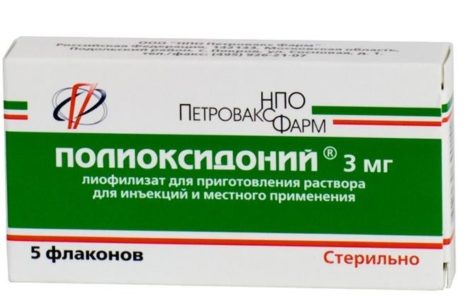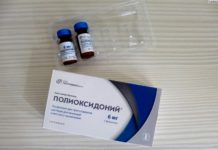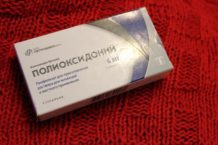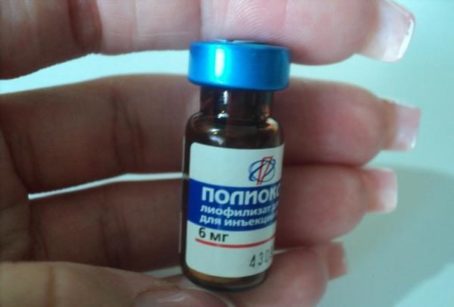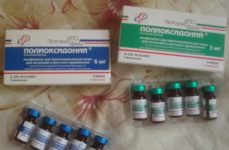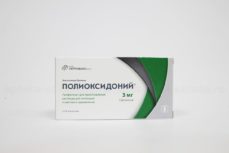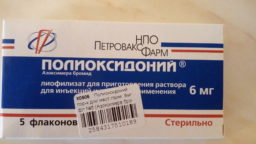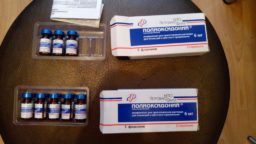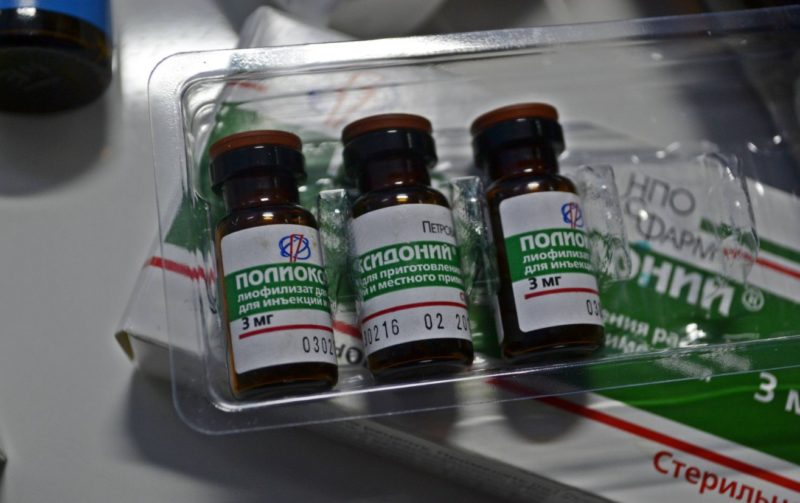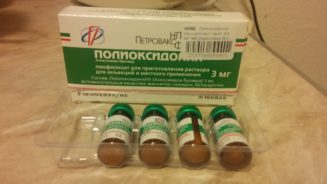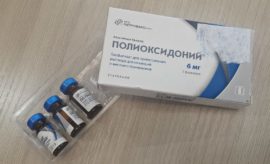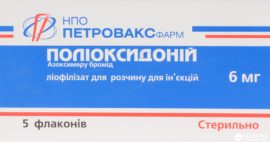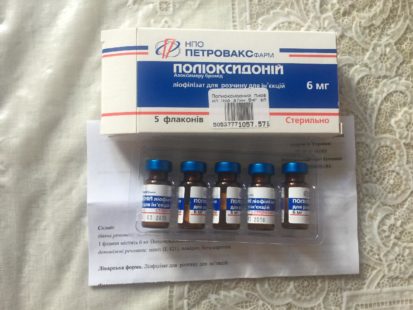Polyoxidonium - injections that are very popular for treatment in the pediatric and therapeutic department. They contribute to the improvement of the protective functions of the body. Often, this drug is prescribed in cases where nothing else helps.
Material Content:
Description of the release form and composition
The immunomodulator can be produced in three forms:
- Pills.
- Suppositories (candles).
- Lyophilisate (injections).
Regardless of the form of release, its main active ingredient is azoximer bromide. The only difference is that the concentration changes.
When prescribing injections, a dry component is used, which must be diluted in 1.5 ml of a special liquid (sterile water, saline).
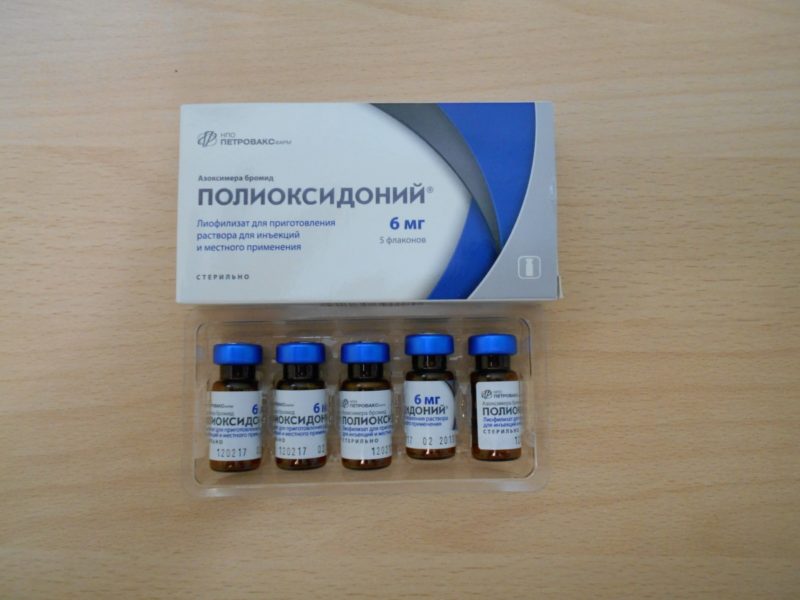 The concentration of drugs may vary:
The concentration of drugs may vary:
- azoximer bromide - 3-6 mg;
- mannitol - 0.9-1.8 mg;
- povidone - 0.6-1.2 mg.
Lyophilisate "Polyoxidonium" is prescribed for intravenous, intramuscular, intranasal and sublingual use based on the results of analyzes and a possible diagnosis.
What Polyoxidonium Injections Help
Basically, the medication is used as a comprehensive treatment for children from 6 months old with preventive measures against acute respiratory infections, influenza, as well as various chronic infectious diseases.
The use of "Polyoxidonium" contributes to:
- reducing the period of elimination of intoxication syndrome;
- reduce the amount of damaged tissue;
- eliminating the likelihood of complications;
- obtaining a long anti-inflammatory effect;
- shortening the duration of treatment;
- the weakening or complete disappearance of the symptoms of a chronic infection;
- reduce the toxic effects of anti-inflammatory drugs on the body;
- increase efficiency.
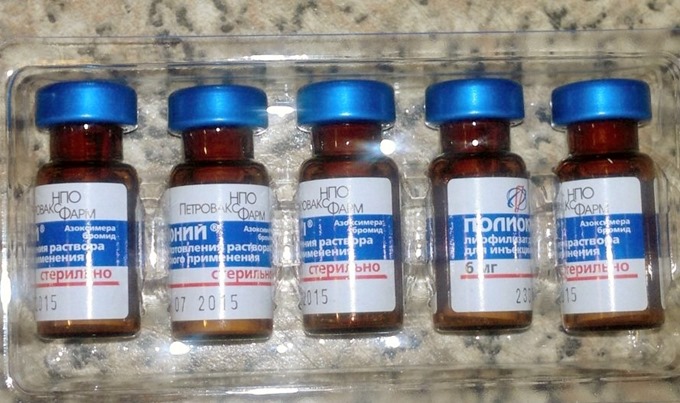 In addition, injections are prescribed for adults if diagnosed with:
In addition, injections are prescribed for adults if diagnosed with:
- tuberculosis;
- chronic infectious diseases;
- asthma, hay fever, dermatitis, allergies;
- urogenital infectious and inflammatory disease;
- oncology;
- arthritis and acute respiratory infections with complications;
- fracture, burns and ulcers;
- recovery period after surgery.
For children:
- SARS, adenoiditis, sinusitis, rhinitis;
- asthma with complications;
- intestinal dysbiosis;
- acute allergy and toxic-allergic reaction;
- radiation dermatitis with complications;
- rehabilitation period after frequent and prolonged illnesses.
Instructions for use for adults and children
Intramuscular administration:
- For adults, Polyoxidonium 6 mg injections are diluted in 1.5-2 ml of medical water or 0.9% sodium chloride solution.
- For children - the adult dosage is reduced exactly 2 times.
Intravenous drip application:
- For adults, 6 mg of powder is diluted in 2 ml of 5% dextrose, 0.9% sodium chloride, hemodes-H or reopoliglukin. Then the resulting mixture must be dissolved in 250-450 ml of the selected substance.
- Children - 3 mg diluted in 1.5 ml of one of the above drugs. The resulting mixture is combined with a 150-250 ml bottle of the selected substance.
Intranasal application:
- For adults, 6 mg of powder is diluted per 1 mg of 0.9% sodium chloride or boiled water at room temperature.
- For children - the adult dosage is halved.
A similar solution is used for sublingual administration. It is stored no longer than a week in the refrigerator.
“Polyoxidonium” injections for children are prescribed extremely rarely. More often for local use. Before using the solution, the composition should be warmed to room temperature. To facilitate the calculation of a single dosage, an approximate daily norm is used based on the body weight of the child:
- up to 6 kg - 5 cap .;
- up to 11 kg - 10 cap .;
- up to 16 kg - 15 cap .;
- up to 21 kg - 20 cap.
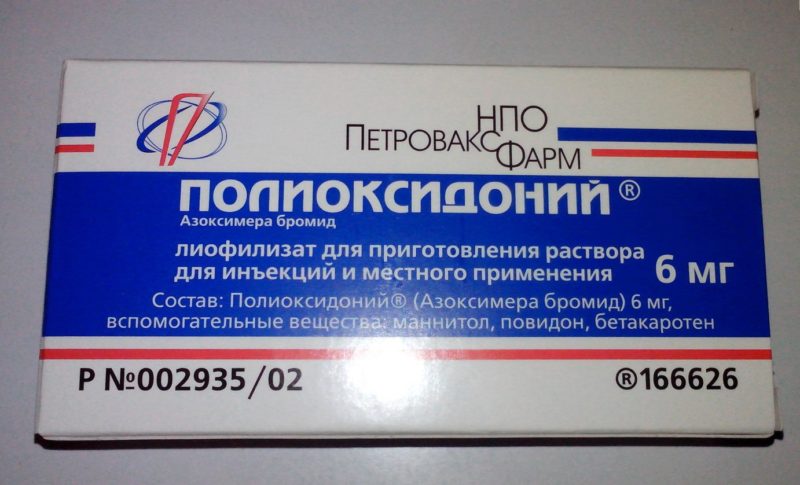 Nasal drops are designed to be taken every 3.5 hours for 1-2 cap. The course is up to 10 days. Under the tongue, also 2 drops, but every 2.5 hours. The course is up to 20 days.
Nasal drops are designed to be taken every 3.5 hours for 1-2 cap. The course is up to 10 days. Under the tongue, also 2 drops, but every 2.5 hours. The course is up to 20 days.
For the smallest (from 6 months to 5 years), the dosage of the drug is calculated based on body weight. Per 1 kg of weight can be no more than 150 μg of dry matter, despite the fact that 3 mg includes 3000 μg. In the period of exacerbation of inflammatory processes, injections are made 1 time in 2 days. The course of treatment is from 5 to 7 injections.
Due to the fact that injections accompany a very painful sensation, the drug is administered very slowly. In the absence of allergic reactions, 0.25% novocaine in a volume of 1 ml is added to the ampoule.
The method of administration and dosage is established taking into account the diagnosis, clinical tests and age category of the patient.
During pregnancy and lactation
Pregnant and breastfeeding this drug is strictly contraindicated.
Animal studies have not revealed teratogenic and embryotoxic effects on the child.
Drug interaction
The combination of "Polyoxidonium" is permissible with substances of antibacterial, antiviral and antifungal effects. And also with antihistamine medications (anti-allergic), glucocorticosteroids and cytostatics.
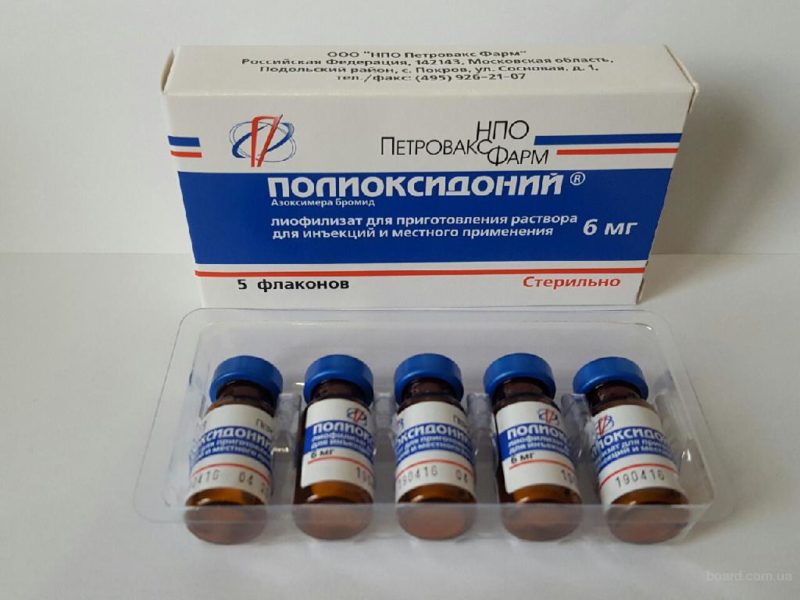
The simultaneous use of drugs increases their ability to fight infection, accelerates the cleansing and healing of the body.
Contraindications, side effects and overdose
The presence of contraindications to the drug depends on its form of release. When injecting them, they are the following factors:
- patient's age is less than 6 months;
- period of pregnancy and lactation;
- hypersensitivity and individual intolerance to individual elements;
- violations in the liver and kidneys.
Subject to the recommended dosages of the drug and the treatment time, Polyoxidonium does not cause side effects.The instruction for use states that in extremely rare cases, with the introduction of the composition, the following reactions can be observed:
- redness
- itching
- burning;
- the appearance of painful compaction;
- increase in body temperature;
- slight short chills.
If any of the listed symptoms appears, you must immediately stop taking it and consult a doctor for advice.
To date, cases of drug overdose have not been reported.
Analogs Polyoxidonium in injections
"Polyoxidonium" - injections for adults and children who do not have medicinal analogues with a similar composition. But there are drugs that have a similar effect on the body:
- "Immunomax" - injections for intramuscular administration. The action is aimed at restoring weak immunity, as well as the treatment of diseases caused by the papilloma virus.
- "Galavit" - injections for intramuscular administration. The action is aimed at eliminating disorders in the gastrointestinal tract due to the presence of an infectious disease, as well as combating hepatitis, herpes, papilloma virus, burns, purulent lesions and flu.
- "Imunofan" - injections for intramuscular and subcutaneous administration. The action is aimed at eliminating the immunodeficiency state, infectious and inflammatory lesions and toxic processes in the body.
"Polyoxidonium" is a medication that is dispensed exclusively by prescription. A highly effective immunomodulator, it activates the protective functions of the body and allows it to fight the disease more productively. Before taking, be sure to consult a specialist.
- Tatna Tikhomirova


